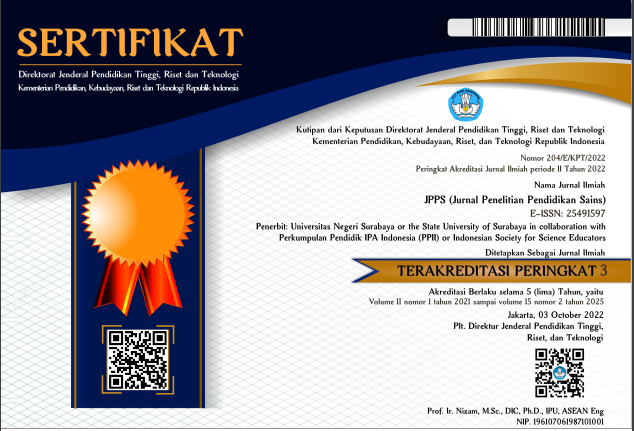CREATIVE THINKING SKILLS IN SUB MATERIAL FACTOR AFFECTING THE RATE OF REACTION WITH THE APPLICATION OF ONLINE-BASED WORKSHEETS ON GUIDED INQUIRY
DOI:
https://doi.org/10.26740/jpps.v10n2.p1983-1995Keywords:
Implementation of guided inquiry Student Worksheet creative thinking skills, factors that affect the rate of reactionAbstract
One of the skills that must be possessed in the 21st century is the ability to think creatively. This study aims to apply student worksheets (LKPD) to improve creative thinking skills through guided inquiry learning models. The research method used a quantitative descriptive method where only one class was used without a comparison class with a one-group pretest-posttest research design. The instruments used were observation sheets of guided inquiry implementation, student activities, knowledge test sheets, creative thinking skills test sheets, and student response questionnaires. The research results obtained data: (1) The implementation of guided inquiry learning models at the first and second meetings went well with a percentage of 97.72% and 98.71%. (2) The percentage of relevant activities is higher than in irrelevant activities. (3) The learning outcomes of the knowledge test and the creative thinking skills test increased as evidenced by the N-gain value on the knowledge test of 0.79 with the high category and the creative thinking skills test of 0.77 with high criteria (4) The results of the response of students showed a response positive as evidenced by the results of the classical questionnaire percentage of 87.3% with the very good category. This shows that learning by applying guided inquiry-based LKPD is effective for improving students' creative thinking skills on the sub-material factors that affect the rate of reaction.
Downloads
References
Anam, K. (2015). Pembelajaran berbasis inkuiri metode dan aplikasi. Yogyakarta: Pustaka Pelajar. Arends, R. (2015). Learning to teach, 10th edition. New York: McGraw-Hill Companies inc.
Fatmawati, A., Zubaidah, S., Mahana, S., & Sutopo. (2019). Critical thinking, creative thinking, and learning achievement. Journal of Physics, 9(1), 21-29.
Mayasari, P.I.K & Yonata, B. (2019). Pengembangan lembar kerja siswa berbasis inkuiri terbimbing untuk melatihkan keterampilan berfikir kreatif pada materi laju reaksi. Skripsi. Surabaya: Universitas Negeri Surabaya.
Munandar, U. (2014). Pengembangan Kreativitas Anak Berbakat. Jakarta: Rineka Cipta.
Nursa'adah, F.P & Rosa, N.M. (2016). Analisis kemampuan berpikir kreatif kimia ditinjau dari adversity quotient, sikap ilmiah dan minat belajar. Jurnal Ilmiah Pendidikan MIPA, 6(3), 35-45.
Pada, A.U.T., Kartowagiran, B., & Subali, B. (2016). Separation index and fit items of creative thinking skills assessment.Research and Evaluation in Education, 2(1), 28-35.
Praswoto, A. (2012). Panduan Kreatif Membuat Bahan Ajar Inovatif. Yogyakarta: Diva Press. Riduwan. (2015). Skala Pengukuran Variabel-Variabel Penelitian. Bandung: Alfabeta. Roestiyah, N.K. (2012). Strategi Belajar Mengajar. Jakarta: Rineka Cipta.
Sandika, B & Fitrihidajati, H. (2018). Improving creative thinking skills and scientific attitude through inquiry-based learning in basic biology lecture toward student of biology education. Jurnal Pendidikan Biologi Indonesia, 4(1), 23-30.
Sanjaya, W. (2014). Strategi Pembelajaran. Pertama. Jakarta: Kencana Prenada Media Group.
Sugiyanto, F.N., Masykuri, M., & Muzzazinah. (2018). Analysis of senior high school students creative thinking skills profile in Klaten regency. Journal of Physics, 1006(1), 1-5.
Downloads
Published
How to Cite
Issue
Section
License
Copyright (c) 2021 JPPS (Jurnal Penelitian Pendidikan Sains)

This work is licensed under a Creative Commons Attribution-NonCommercial 4.0 International License.
 Abstract views: 372
,
Abstract views: 372
, PDF Downloads: 334
PDF Downloads: 334












